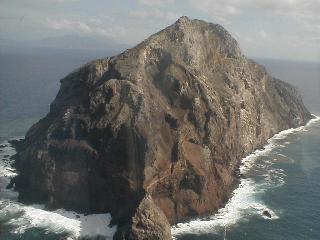Some Basics about Antigua

Redonda |
Together with its "sister island", Barbuda, and the uninhabited rock called
Redonda, Antigua forms the state of Antigua and Barbuda. Antigua's area is
about 280 sq km, Barbuda's is about 160 sq km, and
Redonda is negligible. (As a comparison for Europeans: Scotland alone has ten
islands larger than that.)
The total population is close to 70,000 people,
of which about 1,500 live on Barbuda and probably about 40,000 in
the capital, St. John's.
See the CIA
World Factbook for further details.
Weather
The temperature on Antigua seldom ever falls below 20°C, i.e. on the coldest
days you might want to wear a sweater over your T-shirt in the evenings.
The climate is most pleasant from November to February, and becomes hotter
and more humid during the rest of the year. The time between June and November
is called the "Hurricane Season" because hurricanes are most likely during
these months. It never snows on Antigua, and ice is something you buy at
the petrol station to keep your drinks cool.
If you stay on Antigua for a long time, you will notice that there is much
less sesaonal variation in the weather than in other parts of the world.
During a year in central Europe, you will usually encounter a temperature
range from somewhere below 0°C to somewhere around 30°C, and you will see
6-hour days as well as 14-hour days, with plants and animals (and humans)
changing their behaviour accordingly. Not so on Antigua; there are
seasonal variations but they are much less pronounced.
Check the current weather in St. John's with weather.com.
Sky
I'm not a hobby astronomer but I was very impressed by the huge number of stars
visible from Antigua at night. For me, as a European, the moon was also very
interesting - I'm used to see the new moon as a "C" shape in the sky, while
on Antigua it looked rather like a bathtub.
Currency
The Eastern Caribbean Dollar (EC$, XCD) is Antigua's official currency. It
is linked to the US dollar using an exchange rate of 2.67 EC$ per US$.
(Convert your currency at Yahoo.)
Major credit cards are widely accepted; shop assistants will often convert an
amount from EC$ to US$ before charging your card. You will be able to pay
in US$ almost everywhere, but people will often use the (easier to use)
exchange rate of 2.5 for that. Also, I think it's a nice gesture to use their
currency since they have gone through all the trouble of creating it. The EC$
is also used on all other Eastern Caribbean states, except those belonging to
the USA (they use the US$) and France (they use the French Franc/Euro).
Frederik Ramm, 2001-05-23

